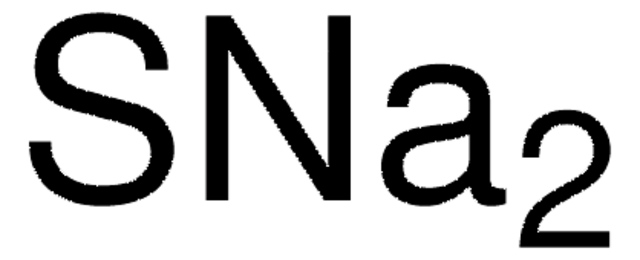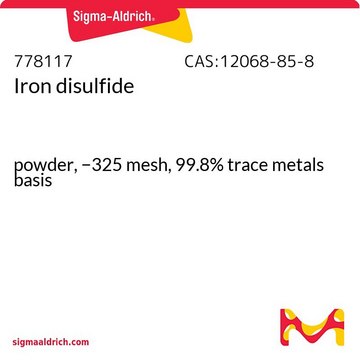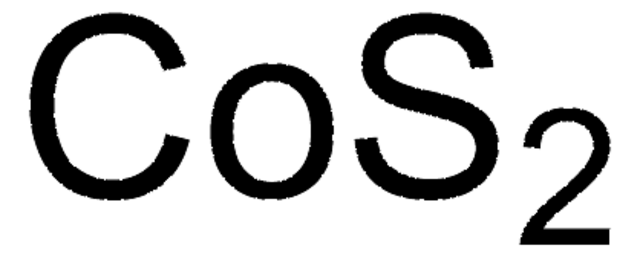244627
Zinc sulfide
powder, 10 μm, 99.99% trace metals basis
Synonym(s):
Zinc sulphide
Sign Into View Organizational & Contract Pricing
All Photos(2)
About This Item
Linear Formula:
ZnS
CAS Number:
Molecular Weight:
97.46
EC Number:
MDL number:
UNSPSC Code:
12161600
eCl@ss:
38150412
PubChem Substance ID:
NACRES:
NA.22
Recommended Products
Quality Level
assay
99.99% trace metals basis
form
powder
reaction suitability
core: zinc
reagent type: catalyst
particle size
10 μm
density
4.1 g/mL at 25 °C (lit.)
SMILES string
S=[Zn]
InChI
1S/S.Zn
InChI key
WGPCGCOKHWGKJJ-UHFFFAOYSA-N
Looking for similar products? Visit Product Comparison Guide
Application
Uses:
- Preparation of flexible transparent conductive coatings essential for fabrication of a variety of printed electronic devices such as flexible displays and solar cells
- Prepare a composite CdS-ZnS/Zirconium-titanium phosphate (ZTP) photocatalyst for hydrogen production under visible light
- Prepare light-controlled bioelectrochemical sensors based on CdSe/ZnS quantum dots
- Catalyst for photocatalytic degradation of organic pollutants
- Preparation of color tunable light-emitting diodes (LEDs)
- Prepare (CdS-ZnS)-TiO2 combined photocatalysts for electricity production via photoelectrocatalysis
- Catalyst for synthesis of spirooxindole derivatives in aqueous medium via Knoevenagel condensation followed by Michael addition
- Prepare CdSe/ZnS q uantum dots for chemiluminescent and chemiluminescence resonance energy transfer (CRET) detection of DNA, metal ions, and aptamer-substrate complexes
- Preparation of ZnS nanocrystals for ultrasensitive protein detection in terms of multiphonon resonance Raman scattering
Zinc sulfide can be used:
- To prepare flexible transparent conductive coatings essential for fabrication of a variety of printed electronic devices such as flexible displays and solar cells.
- To prepare a composite CdS-ZnS/zirconium-titanium phosphate (ZTP) photocatalyst for hydrogen production under visible light.
- To prepare light-controlled bioelectrochemical sensors based on CdSe/ZnS quantum dots.
- As a catalyst for the photocatalytic degradation of organic pollutants.
- In the preparation of color tunable light-emitting diodes (LEDs).
- To prepare (CdS-ZnS)-TiO2 combined photocatalysts for electricity production via photoelectrocatalysis.
- As a catalyst for the synthesis of spirooxindole derivatives in aqueous medium via Knoevenagel condensation followed by Michael addition.
- To prepare CdSe/ZnS quantum dots for chemiluminescent and chemiluminescence resonance energy transfer (CRET) detection of DNA, metal ions, and aptamer-substrate complexes.
- To prepare ZnS nanocrystals for ultrasensitive protein detection in terms of multiphonon resonance Raman scattering.
Storage Class
13 - Non Combustible Solids
wgk_germany
nwg
flash_point_f
Not applicable
flash_point_c
Not applicable
ppe
Eyeshields, Gloves, type N95 (US)
Choose from one of the most recent versions:
Already Own This Product?
Find documentation for the products that you have recently purchased in the Document Library.
Customers Also Viewed
Photocatalysis and photoelectrocatalysis using (CdS-ZnS)/TiO2 combined photocatalysts.
Antoniadou M, et al.
Applied Catalysis. B, Environmental, 107(1-2), 188-196 (2011)
White light generation using CdSe/ZnS core?shell nanocrystals hybridized with InGaN/GaN light emitting diodes.
Nizamoglu S, et al.
Nanotechnology, 18(6), 065709-065709 (2007)
hemiluminescent and chemiluminescence resonance energy transfer (CRET) detection of DNA, metal ions, and aptamer?substrate complexes using hemin/G-quadruplexes and CdSe/ZnS quantum dots.
Freeman R, et al.
Journal of the American Chemical Society, 133(30), 11597-11604 (2011)
Flexible transparent conductive coatings by combining self-assembly with sintering of silver nanoparticles performed at room temperature.
Layani M and Magdassi S
Journal of Materials Chemistry, 21(39), 15378-15382 (2011)
Ultrasensitive protein detection in terms of multiphonon resonance Raman scattering in ZnS nanocrystals.
Chu X, et al.
Applied Physics Letters, 98(25), 253703-253703 (2011)
Our team of scientists has experience in all areas of research including Life Science, Material Science, Chemical Synthesis, Chromatography, Analytical and many others.
Contact Technical Service







